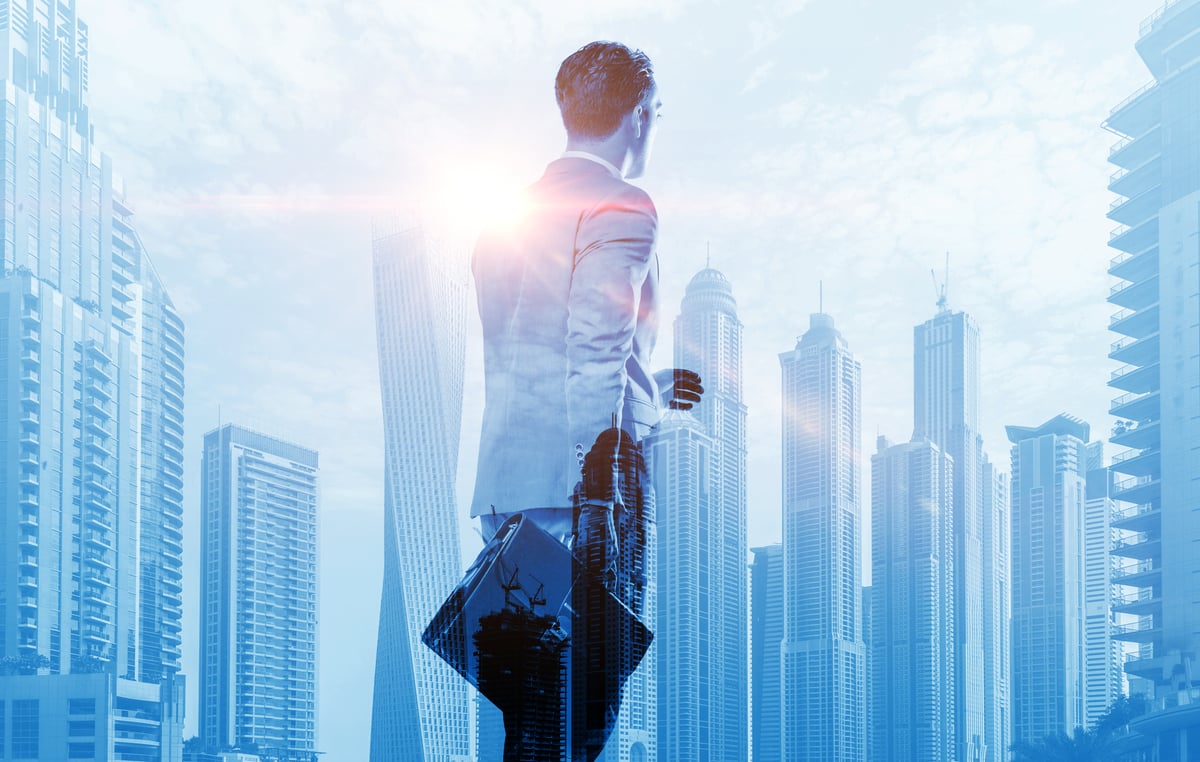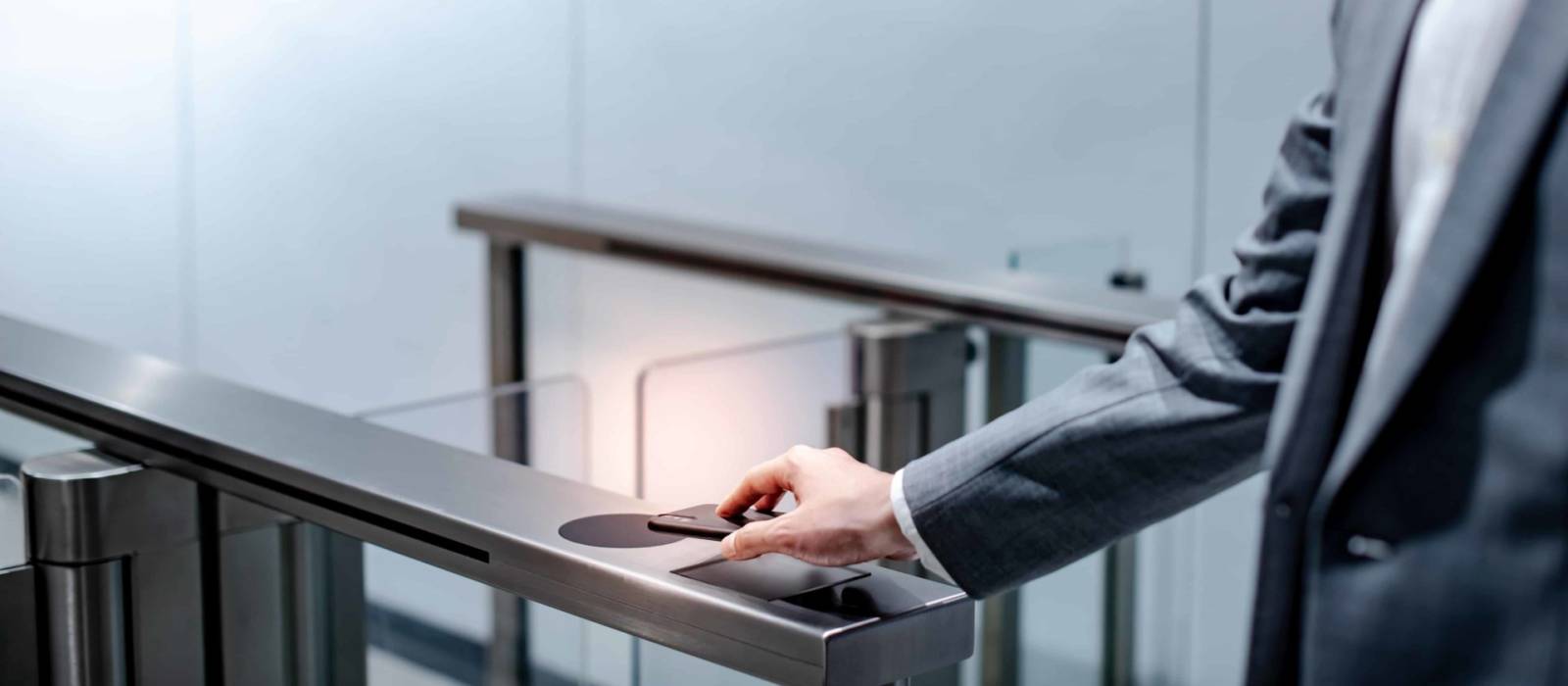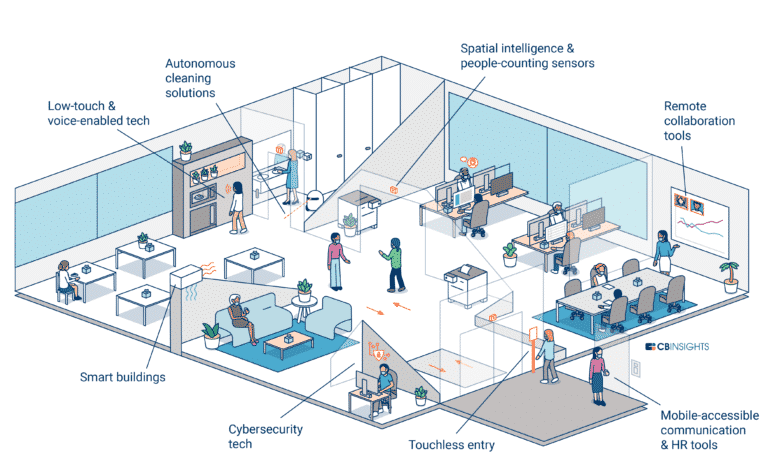
What will the office of the future look like?
COVID-19 has paved the wave for a redefinition of the ‘workplace’, prompting employers and employees to ask themselves, “What will the office of the future will look like?”. The answer depends on the individual needs of each organization, but there are some common elements that research suggests are necessary for companies to thrive in a post-COVID era.
We’ve done the research for you, and below break down important insights and predictions to help give you a sense of what your future office could look like.
To learn how to deliver a positive workplace experience amidst the pandemic, check out our recent webinars.
Our team is here to help you automate COVID-safety in your office, from social distancing to contract tracing. To see how it works book a demo.
Changes to Physical Office Space/ Implementing new Technology

According to intelligence analytics platform CB Insights, “Moving forward, many companies will likely reconsider their corporate real estate footprint, whether that involves downsizing or redistributing space to satellite offices. A completely remote workforce seems unlikely, given the intangible benefits of social connection, collaboration and innovation that in-person working provides. Nonetheless, it will be crucial to create optimal conditions for employees to work remotely as well as in the office.”

Specifically, CB Insights has created an infographic showing different technologies that might become prevalent in an office setting as people try to find a new normal, including:
- Pre-entry wellness checks
- Touchless entry
- Social distance sensors
- Remote collaboration tools
- Cyber security and at home network security
- Employee wellness, communication and engagement tools
- Low touch and voice enabled tech
- Autonomous cleaning solutions
Similarly, a recent CBNC article entitled “After coronavirus: The office of the future is the office of the past” delved into some physical design changes and technologies that might become the new norm in offices. Here are a few of the changes referenced in the CNBC article:
- Wider corridors with one-way foot traffic
- Better air filtration
- Touchless elevator controls
- Antimicrobial materials in new construction
- Videoconferencing even within the office to avoid the conference room
Another major piece of technology that will be essential as people return to the office is desk booking software. Software like Smartway2 can boost collaboration and productivity, increase space utilization and improve employee experience by enabling people to book the desks, meeting rooms, parking, equipment or any other facilities they need in advance. Smartway2 helps protect workers amidst the pandemic by automating social distancing, contact tracing and sanitation procedures.
Activity-Based Working

Research has shown employees want the flexibility to determine when and where they complete their jobs, and employers are responding. With that said, as employers rethink their office space in a post-COVID environment, we recommend considering activity-based working, or ABW.
Implementing ABW into your office means providing different spaces that allow workers to pick and choose areas that best meet their needs at a particular point in time, e.g. bean bag areas with white boards for brainstorming, or focus booths for quiet concentration. The idea of ABW centers around a more agile work environment.
AESC (the Association of Executive Search and Leadership Consultants) published an article on the office of the future, which included a quote from Christhina Candido, Associate Professor and Director of the Sustainable and Healthy Environments Lab at University of Melbourne: “People are starting to realize that we need to be provided with different types of infrastructure, different spaces within the same open office plan to actually do all of our activities, because we don’t do the same thing during the whole day. There are parts of our day that we need to go to a space to concentrate, there are parts of the day where you actually are happy to hang out with colleagues. And there are times that you actually need to have a moment to yourself.”
A recent New York Times article also focused on the need for companies to create more customized space, reporting, “The office will become more of a consumer product. And just like every consumer product, the office will have to continually fight for its customers and meet their needs — not only when it’s time to renew the lease. Offices will need spaces for specific tasks like focused work, team brainstorming, client presentations and employee training. And they will need to be more focused on individuals, even if these people work for a large company.”
The Transition

Changes at the office are not going to happen overnight. Companies will need to determine on an individual basis what makes sense for their employees.
Research has suggests a hybrid working arrangement will become more prevalent, meaning employees working both from home and from the office. A survey by Xerox found that “56 percent of respondents are expanding their technology budgets in anticipation of new requirements stemming from fully remote or hybrid workplace arrangements.”
Consulting firm McKinsey & Company has found that moving forward employees will be given more choice when it comes how, when and where they work. McKinsey published a report that determined, “The pandemic has forced the adoption of new ways of working. Organizations must reimagine their work and the role of offices in creating safe, productive, and enjoyable jobs and lives for employees.”
The report touches on 4 categories of workers: fully remote work, hybrid remote work, hybrid remote by exception and fully onsite work.
McKinsey also lists 4 steps to “reimagine work and workplaces:”
- Reconstruct how work is done
- Decide ‘people to work’ or ‘work to people’
- Redesign the workplace to support organizational priorities
- Resize the footprint creatively
Similarly, Strategy + Business Magazine compiled a list of 4 actions that they believe are necessary to transition into the “office of the future:”
- Redefine the role of the office
- Define work-from-home guidelines
- Remodel the office
- Update your ways of working
To read more about hybrid work environments, check out our blog post.
Data-driven Insight

Data from commercial real estate services and investment firm CBRE points to changes in the physical office space many of us have grown accustomed to over the years. CBRE found, “Transformation towards collaborative design will accelerate. As the role of the office evolves to favor teamwork over individual work, design will likely follow suit – 70% are planning to operate in a significantly “free address” environment to support a more mobile workforce.” The findings continue on to say, “Flexible solutions are attracting greater interest. 56% are considering more use of flexible office space, as it offers unprecedented ability to plan for uncertainty – 82% indicate flexibility is a desired attribute as they select buildings to lease in the future.”
Smartway2 helps organizations boost productivity, collaboration and space utilization, by enabling employees to book everything they need to do their best work, on-demand – from desks and space, to parking and equipment.


